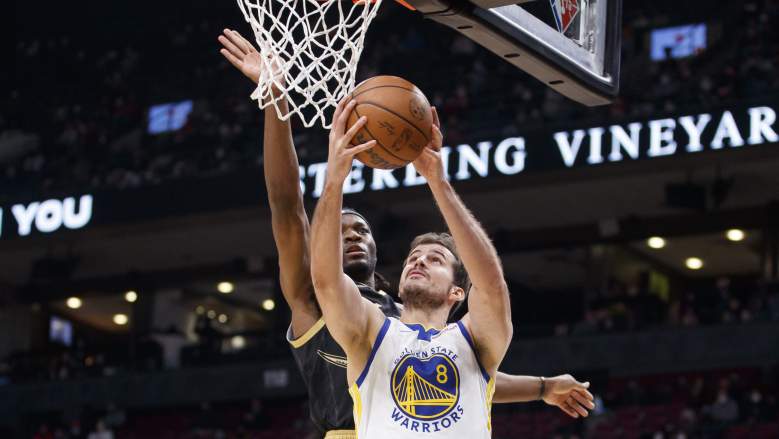
Getty Warriors forward Nemanja Bjelica driving against the Toronto Raptors during December 18 match-up.
In the NBA, being able to identify impact players is the most essential step towards success. However, there is more to roster construction than just correctly identifying a future superstar in the lottery or signing a former MVP in free agency.
Hitting in the margins, and locating legitimate talent to round out your roster is a major advantage. Draymond Green, drafted 35th overall in 2012, is a great example of that. Jacob Evans, drafted 28th overall in 2018, is not.
Going into the 2021-2022 season, however, the Golden State Warriors stepped it up. Not only did they hang onto Gary Payton II, who played 10 games for them last season, they also added Otto Porter Jr. and Nemanja Bjelica, both of whom have stepped up over the course of the season.
The Bench Push
Stars might dictate how far a team goes, especially in the playoffs, but having a strong bench can help keep starters fresh and even lower their minute burden during the regular season. Currently only one Warrior – Stephen Curry – averages over 32 minutes per game, with a whopping 11 players playing over 15 minutes per game.
This is doable because general manager Bob Myers and his team routinely won in the margins during the offseason. Porter is averaging 8.0 points and 5.0 rebounds per game, while hitting 40.0% from behind the three-point line and playing both forward spots. While his defense isn’t always what it used to be, largely in part due to a string of injuries, he’s been able to step in and play starting caliber basketball when the need has risen.
During the Christmas Day slate, the Warriors met the Phoenix Suns on the road, missing both Andrew Wiggins and Jordan Poole. Porter started in place of Wiggins and produced 19 points, six rebounds, three assists, and hit three three-pointers, helping the Warriors to a 9-point win.
Payton, who started in place of Poole, scored 14 points, grabbed eight rebounds and played his usual elite defense.
To be able to have not one, but two players on minimum contracts, per Spotrac, capable of stepping into the starting line-up and producing starting caliber numbers, is a major asset to any team’s Championship aspirations.
To make things even more encouraging, Bjelica has come off the bench offering steady play, scoring 6.8 points per game, while grabbing 3.8 rebounds, dishing 1.7 assists, and swishing 39.5% of his three-point attempts in just 15.1 minutes per game.
The 33-year-old Serbian could easily play 25 justified minutes per game due to his versatile skill set, but having him come off the bench has afforded head coach Steve Kerr to keep a presence of stability, while players are in and out of the lineup due to entering health and safety protocols.
That may change Tuesday, given that Green has also entered those protocols. Kerr could start rookie Jonathan Kuminga or veteran Juan Toscano-Anderson for defensive purposes, but with Green out, the Warriors will be in need of an additional playmaker. Bjelica is one of the better passers on the team.
Bench Quality Means Possibilities
For most teams making a Finals run, of which the Warriors are considered the Western Conference favorites according to FanDuel Sportsbook, rotations tighten the closer a team gets to the Finals. Stars are getting a bump in minutes, and some bench players might get squeezed out of the rotation entirely.
Championship contenders with depth, such as the Warriors, can thus go in two directions.
Direction 1: Use the depth during the early stages of the playoffs to save as much time as possible before unleashing starters to 40-minute roles in crucial series against quality opponents.
This would, in theory, benefit most starters while maintaining team chemistry. An added bonus in keeping everyone around is in the event of an injury, you’ll be able to plug holes. A potential downside to this strategy is simply letting some of that depth go to waste when the rotation shortens.
Direction 2: Improve the quality of the rotation by trading a few high-quality rotation pieces for one even better rotation piece, or potential starter.
This is the high-upside, all-in play. It has merits in being able to strengthen the primary rotation, thus theoretically offering you a better chance at winning the whole shebang. The downside here is that you’d be more affected by a significant injury and would have less flexibility in plugging holes.
There isn’t necessarily any right or wrong answer to which approach a team should take. It’s all about temperament. For the Warriors specifically, just being able to have those options is a win in and of itself.